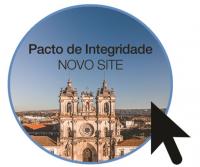- HOME
- MONUMENT
- VISIT OUR MONUMENT
- HERITAGE LEARNING
- ALCOBAÇA
- MONASTERIRES ROUTE

The Monastery Complex
The complex of Alcobaça Monastery is one of the most notable and best conserved examples of Cistercian architecture and spatial philosophy.
Alcobaça was the last abbey founded in St. Bernard’s lifetime and the first wholly Gothic building in Portugal. The abbey was founded in 1153, when King Afonso Henriques donated the land to Bernard of Clairvaux (St. Bernard).
Construction work on the building as we see it today only began in 1178 and lasted several decades, which is understandable considering the absolutely exceptional dimensions of the project.
The religious brotherhood occupied the already completed buildings in1223 and followed a programme of prayer and manual work (“ora et labora”).
The chosen site, set in rich and fertile land, coincided with the Cistercian policy of agrarian development. A special canal system was built to diverting drinking water from the River Alcoa; the hydraulic system is impressive for the technical solutions applied. The whole surrounding region was covered with granges, vineyards, orchards and arable land claimed from forests and marshes by means of assartment.
The church, 100 metres in length, is the largest Gothic religious structure in Portugal.
Its Latin cross layout features an ambulatory with nine side chapels.
The accentuated height of the church’s interior (more than twenty metres) gives it unmatched grace.
Particularly noteworthy is the use of flying buttresses on the outside of the high altar.
The transept currently houses the tombs of King Pedro and Lady Inês de Castro.
The other mediaeval spaces – the Chapter House, Refectory, Monks’ Room and Dormitory – were built in the 13th and 14th centuries. King Dinis commissioned the Cloister of Silence, the largest mediaeval cloister in Portugal.
Under Manuel I the monastery works were given fresh impetus: he commissioned the New Sacristy and the upper tier in the Cloister of Silence (the Upper Cloister), new pews for the church and a library, the location of which is not known today. Of this extensive works programme only the Sacristy atrium and the Upper Cloister have survived.
The kitchen, which is fully tiled, dates from 1752. Its most impressive features are the chimney supported by eight wrought iron columns and the water basin which held water brought via thee canal system – an example of the ingenuity of the Cistercian monks in the field of hydraulic engineering.
The monumentality, beauty and purity of Alcobaça Monastery warranted its inscription in the list of UNESCO World Heritage Sites in 1989.
SERVICES - ACTIVITIES



